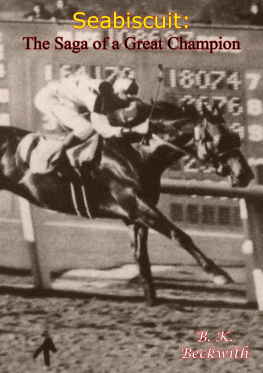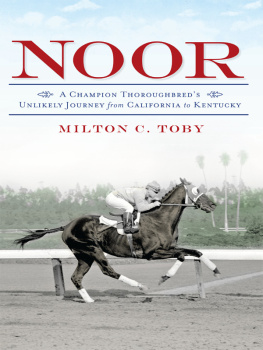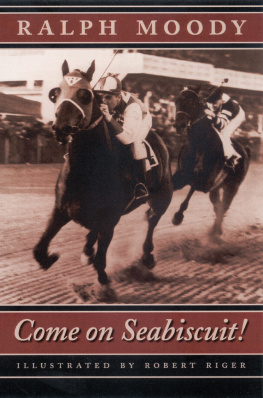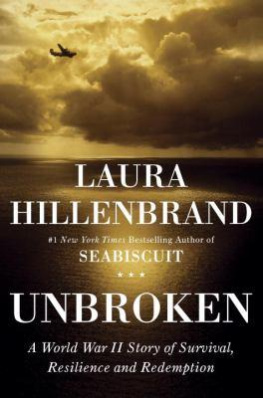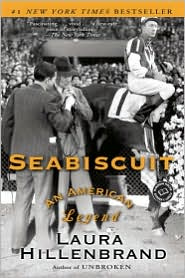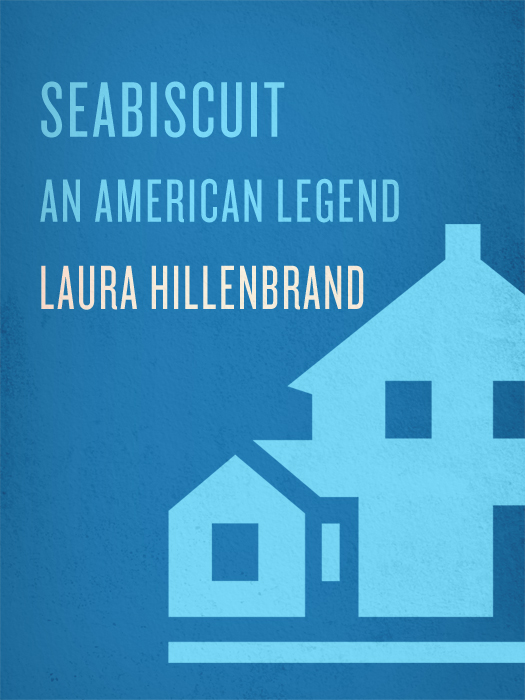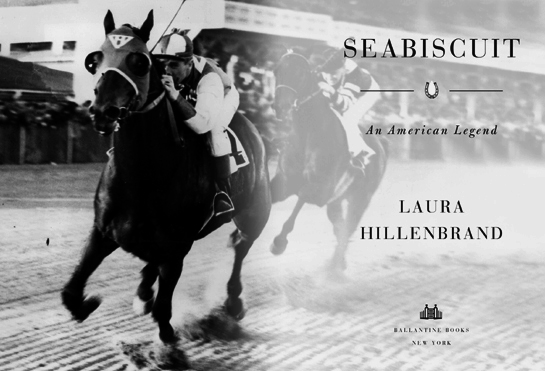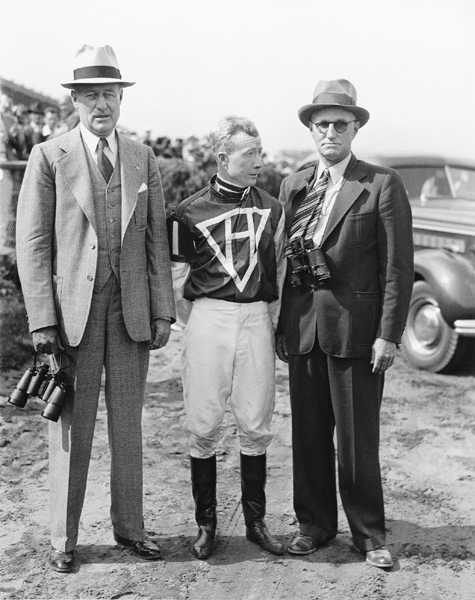
Charles Howard, Red Pollard, and Tom Smith
(KEENELAND-COOK)
For Borden
Nobody ever lives their life all the way up except bullfighters.
ERNEST HEMINGWAY, THE SUN ALSO RISES
CONTENTS
PREFACE
I n 1938, near the end of a decade of monumental turmoil, the years number-one newsmaker was not Franklin Delano Roosevelt, Hitler, or Mussolini. It wasnt Pope Pius XI, nor was it Lou Gehrig, Howard Hughes, or Clark Gable. The subject of the most newspaper column inches in 1938 wasnt even a person. It was an undersized, crooked-legged racehorse named Seabiscuit.
In the latter half of the Depression, Seabiscuit was nothing short of a cultural icon in America, enjoying adulation so intense and broad-based that it transcended sport. When he raced, his fans choked local roads, poured out of special cross-country Seabiscuit Limited trains, packed the hotels, and cleaned out the restaurants. They tucked their Roosevelt dollars into Seabiscuit wallets, bought Seabiscuit hats on Fifth Avenue, played at least nine parlor games bearing his image. Tuning in to radio broadcasts of his races was a weekend ritual across the country, drawing as many as forty million listeners.storms and murderous heat to catch a glimpse of his private eighty-foot Pullman railcar. He galloped over Manhattan on massive billboards and was featured week after week, year after year, in Time, Life, Newsweek, Look, Pic, and The New Yorker. His trainer, jockey, and owner became heroes in their own right. Their every move was painted by the glare of the flashbulb.
They had come from nowhere. The horse, a smallish, mud-colored animal with forelegs that didnt straighten all the way, spent nearly two seasons floundering in the lowest ranks of racing, misunderstood and mishandled. His jockey, Red Pollard, was a tragic-faced young man who had been abandoned as a boy at a makeshift racetrack cut through a Montana hay field. He came to his partnership with Seabiscuit after years as a part-time prizefighter and failing jockey, lugging his saddle through myriad places, getting punched bloody in cow-town boxing rings, sleeping on stall floors. Seabiscuits trainer, a mysterious, virtually mute mustang breaker named Tom Smith, was a refugee from the vanishing frontier, bearing with him generations of lost wisdom about the secrets of horses. Seabiscuits owner, a broad, beaming former cavalryman named Charles Howard, had begun his career as a bicycle mechanic before parlaying 21 cents into an automotive empire.
In 1936, on a sultry August Sunday in Detroit, Pollard, Smith, and Howard formed an unlikely alliance. Recognizing the talent dormant in the horse and in one another, they began a rehabilitation of Seabiscuit that would lift him, and them, from obscurity.
For the Seabiscuit crew and for America, it was the beginning of five uproarious years of anguish and exultation. From 1936 to 1940, Seabiscuit endured a remarkable run of bad fortune, conspiracy, and injury to establish himself as one of historys most extraordinary athletes. Graced with blistering speed, tactical versatility, and indomitable will, he shipped more than fifty thousand exhausting railroad miles,jockey returned to the track together in an attempt to claim the one prize that had escaped them.
Along the way, the little horse and the men who rehabilitated him captured the American imagination. It wasnt just greatness that drew the people to them. It was their story.
It began with a young man on a train, pushing west.
PART I
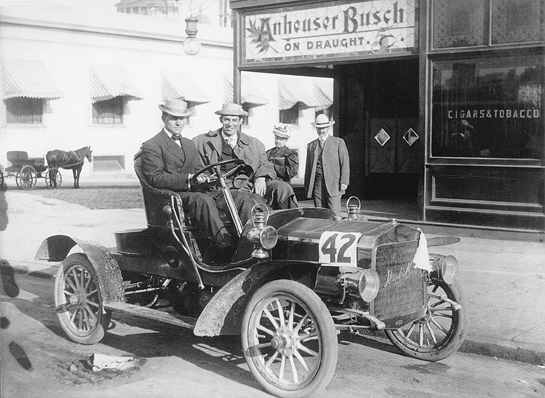
Howard at the wheel of his Buick race car, San Francisco, 1906
(COL. MICHAEL C. HOWARD)
Chapter 1
THE DAY OF THE HORSE IS PAST
C harles Howard had the feel of a gigantic onrushing machine: You had to either climb on or leap out of the way. He would sweep into a room, working a cigarette in his fingers, and people would trail him like pilot fish. They couldnt help themselves. Fifty-eight years old in 1935, Howard was a tall, glowing man in a big suit and a very big Buick. But it wasnt his physical bearing that did it. He lived on a California ranch so huge that a man could take a wrong turn on it and be lost forever, but it wasnt his circumstances either. Nor was it that he spoke loud or long; the surprise of the man was his understatement, the quiet and kindly intimacy of his acquaintance. What drew people to him was something intangible, an air about him. There was a certain inevitability to Charles Howard, an urgency radiating from him that made people believe that the world was always going to bend to his wishes.
On an afternoon in 1903, long before the big cars and the ranch and all the money, Howard began his adulthood with only that air of destiny and 21 cents in his pocket.military-school horses had taught him to carry his six-foot-one-inch frame straight up.
He was eastern born and bred, but he had a westerners restlessness. He had tried to satisfy it by enlisting in the cavalry for the Spanish-American War, and though he became a skilled horseman, thanks to bad timing and dysentery he never got out of Camp Wheeler in Alabama. It seems to have been a good life, but the East stifled Howard. His mind never seemed to settle down. His ambitions had fixed upon the vast new America on the other side of the Rockies. That day in 1903 he couldnt resist the impulse anymore. He left everything hed ever known behind, promised his wife Fannie May hed send for her soon, and got on the train.
He got off in San Francisco. His two dimes and a penny couldnt carry him far, but somehow he begged and borrowed enough money to open a little bicycle-repair shop on Van Ness Avenue downtown. He tinkered with the bikes and waited for something interesting to come his way.
It came in the form of a string of distressed-looking men who began appearing at his door. Eccentric souls with too much money in their pockets and far too much time on their hands, they had blown thick wads of cash on preposterous machines called automobiles. Some of them were feeling terribly sorry about it.
The horseless carriage was just arriving in San Francisco, and its debut was turning into one of those colorfully unmitigated disasters that bring misery to everyone but historians. Consumers were staying away from the devilish contraptions in droves. The men who had invested in them were the subjects of cautionary tales, derision, and a fair measure of public loathing. In San Francisco in 1903, the horse and buggy was not going the way of the horse and buggy.




